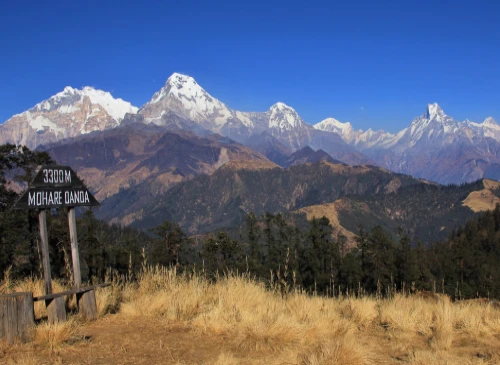In the Annapurna Region, the Ghorepani Poonhill Trek is one of the most well-liked and doable trek for everyone. Those who like the Himalayas' breathtaking scenery and unspoiled beauty might choose this climb. Beautiful rhododendron forests, a variety of sceneries, and an immersive atmosphere await trekkers who take advantage of this wonderful chance. Poonhill's breathtaking vistas of the Dhaulagiri and Annapurna mountain ranges are another reason to visit. It is conveniently located in Pokhara Valley, and you can find yourself among the mountains in a short amount of time.
Are you familiar with Ghorepani Poonhill?
Exploring to Ghorepani Poon Hill Trek
The road to Ghorepani Poon Hill trek is an adventure filled with natural beauty, cultural experiences, and stunning vistas, making it a memorable journey for trekkers. Typically, the trek takes around 4-5 days to complete. The trek usually starts from Nayapul, which is easily accessible from Pokhara. The trail passes through picturesque villages like Tikhedhunga, Ulleri, Banthati, Ghorepani, and Ghandruk.
Ghorepani, a crucial stop before ascending to Poon Hill, serves as a vital resting point. Here, trekkers rejuvenate before the exhilarating climb to Poon Hill's summit. From this point, trekkers get panoramic views of the Annapurna and Dhaulagiri mountain ranges, especially during the sunrise ascent. Eventually, the return path concludes back at Nayapul, concluding an adventure ensuring an unforgettable Himalayan experience for all trekkers.
How Difficult is Ghorepani Poon Hill Trek?
The Ghorepani Poon Hill Trek is moderately difficult due to its elevation of 3,210 meters. It is one of the most relaxing treks in the Annapurna region of Nepal. From Tikhedhunga to Ghorepani, the trail involves a strenuous trek up the stone stairway requiring approximately 6 to 7 hours of trekking every day to complete this significant ascent. Since the journey’s highest point is around 3200 meters, some trekkers might experience signs of acute mountain sickness, but the condition does not worsen. However, it is still necessary to maintain good health to avoid any risks of Mountain Sickness.
The trek's challenge is influenced by factors like altitude, terrain, and weather conditions. Heavy rainfall, landslides, and slippery trails, on the other hand, might make the expedition difficult. To avoid getting lost, trekkers always need to remain on their trekking track.
For travelers who wish to ease the journey, training the body to enhance stamina and endurance is recommended. Before the trek, it is recommended to engage in cardiovascular exercises and undertake day excursions involving steep hill climbs to help prepare for the diverse paths along the hiking trail. With adequate preparation and a steady pace, the Ghorepani Poon Hill Trek offers an achievable and rewarding adventure amidst the picturesque landscapes of Nepal.
Ideal seasosn for Ghorepani Poon Hill Trek
The best times for Ghorepani Poonhill Trek are during the Spring season (March-May) and Autumn (September – November). This timeframe offers clear weather ideal for capturing the best views of the majestic mountains. The landscape is transformed by the stunning display of gorgeous rhododendron blossoms painting the entire landscape in shades of red.
The temperatures remain moderate, with slightly chilly mornings and evenings, while the days offer clear, splendid views of the mountains.
Summer (June-August) is unsuitable for trekking due to heavy rains, resulting in poor visibility, soggy trails, landslides, and path blockages. Meanwhile, trekking in winter (November-February) involves coping with freezing temperatures, but the reward of clear skies unveils breathtaking Himalayan panoramas for those prepared to brave the cold.
Ghorepani Poon Hill Trek Costs
For an all-inclusive tour, you’ll spend between USD 50-60 per person per day, depending on the services you receive, the number of people in your group, food, and transportation arrangements. If you’re traveling from the capital city, Kathmandu, the charge is USD 500 to USD 800 per person for a 5-day trek, including transportation. Rather than hiring a private guide, traveling with a trekking group has advantages.
- Airport arrival and departure
- Three meals a day during the trek
- Trekking permit, TIMS, and other entry fees
- Trekking guide with English-speaking experience and a license
- Teahouse accommodation on the trek
- A route map
A standard rate for both a guide and a porter is around USD50 per day. Your guide will be able to provide first-aid assistance in the event of an emergency. If you hire a porter, make sure he has the proper equipment and is insured.
Ghorepani Poon Hill Trek is only possible with the proper authorization. Unlike an all-inclusive tour, the trekkers must pay a relevant permit fee before the trip. You will not be able to take part in this adventure unless you have obtained a permit from:
Most trekkers will spend USD 40 per day on basic lodging and food. All the guesthouses serve the traditional Nepalese cuisine of rice, dal soup, vegetable curry, alcohol, soft drinks, and snacks priced according to the menu. For a cost of 50-100 NPR, you can refill your water bottle in the teahouse.
Trekkers need to obtain the Annapurna Conservation Area Permit (ACAP) and the TIMS (Trekkers' Information Management System) card before starting the trek. These permits are available in Kathmandu or Pokhara.
Remember, while the Ghorepani Poon Hill trek is relatively accessible, it's essential to be prepared with proper gear, acclimatization, and a reasonable level of fitness to enjoy the trek and its stunning vistas fully. Hiring a local guide or joining a trekking group can also enhance your experience and ensure safety on the trail.
Trekkers should opt for travel insurance, as the trail passes through many remote areas. Insurance covers evacuation and any other expenses incurred due to unanticipated circumstances such as personal illness, natural disasters, political strikes, and so on.








